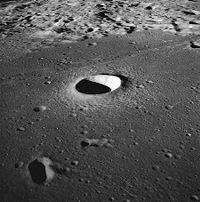.gif)
Hypatia (crater)
Encyclopedia
Hypatia is a lunar
crater
that lies along the northwest edge of Sinus Asperitatis
, a bay on the southwest edge of Mare Tranquillitatis
. The nearest crater with an eponym
is Alfraganus
to the west-southwest. However, farther to the south-southeast, across the lunar mare
, is the prominent crater Theophilus
.
Hypatia is an asymmetrical formation with a rugged, irregular outer rim that is cut through by narrow clefts in several locations. It is generally longer along an axis running to the north-northwest, with the widest outward bulge occurring on the west side at the northern end. It resembles a merger of several crater formations that have gained a common interior floor. Attached to the exterior rim along the southwest is the satellite crater Hypatia A, a more symmetrical, bowl-shaped crater.
 About 70 kilometers to the north of Hypatia is a system of linear rille
About 70 kilometers to the north of Hypatia is a system of linear rille
s designated Rimae Hypatia. This runs for a length of about 180 kilometers across the Mare Tranquillitatis, and generally follows a course to the south-southeast.
Moon
The Moon is Earth's only known natural satellite,There are a number of near-Earth asteroids including 3753 Cruithne that are co-orbital with Earth: their orbits bring them close to Earth for periods of time but then alter in the long term . These are quasi-satellites and not true moons. For more...
crater
Impact crater
In the broadest sense, the term impact crater can be applied to any depression, natural or manmade, resulting from the high velocity impact of a projectile with a larger body...
that lies along the northwest edge of Sinus Asperitatis
Sinus Asperitatis
Sinus Asperitatis is an area of lunar mare that extends southward from the Mare Tranquillitatis until it joins the Mare Nectaris to the southeast. It is bordered along the western and eastern sides by continental regions of irregular terrain...
, a bay on the southwest edge of Mare Tranquillitatis
Mare Tranquillitatis
Mare Tranquillitatis is a lunar mare that sits within the Tranquillitatis basin on the Moon. The mare material within the basin consists of basalt formed in the intermediate to young age group of the Upper Imbrian epoch. The surrounding mountains are thought to be of the Lower Imbrian epoch, but...
. The nearest crater with an eponym
Eponym
An eponym is the name of a person or thing, whether real or fictitious, after which a particular place, tribe, era, discovery, or other item is named or thought to be named...
is Alfraganus
Alfraganus (crater)
Alfraganus is a small lunar impact crater that lies in the rugged highland region to the southwest of the Mare Tranquillitatis. Northwest of Alfraganus is the crater Delambre, and to the south is the irregular Zöllner. The rim of Alfraganus is circular and retains a sharp edge that has not received...
to the west-southwest. However, farther to the south-southeast, across the lunar mare
Lunar mare
The lunar maria are large, dark, basaltic plains on Earth's Moon, formed by ancient volcanic eruptions. They were dubbed maria, Latin for "seas", by early astronomers who mistook them for actual seas. They are less reflective than the "highlands" as a result of their iron-rich compositions, and...
, is the prominent crater Theophilus
Theophilus (crater)
Theophilus is a prominent lunar impact crater that lies between Sinus Asperitatis in the north and Mare Nectaris to the southeast. It partially intrudes into the comparably sized crater Cyrillus to the southwest. To the east is the smaller crater Mädler and further to the south-southeast is Beaumont...
.
Hypatia is an asymmetrical formation with a rugged, irregular outer rim that is cut through by narrow clefts in several locations. It is generally longer along an axis running to the north-northwest, with the widest outward bulge occurring on the west side at the northern end. It resembles a merger of several crater formations that have gained a common interior floor. Attached to the exterior rim along the southwest is the satellite crater Hypatia A, a more symmetrical, bowl-shaped crater.

Rille
Rille is typically used to describe any of the long, narrow depressions in the lunar surface that resemble channels. Typically a rille can be up to several kilometers wide and hundreds of kilometers in length...
s designated Rimae Hypatia. This runs for a length of about 180 kilometers across the Mare Tranquillitatis, and generally follows a course to the south-southeast.
Satellite craters
By convention these features are identified on lunar maps by placing the letter on the side of the crater mid-point that is closest to Hypatia.| Hypatia | Latitude | Longitude | Diameter |
|---|---|---|---|
| A | 4.9° S | 22.2° E | 16 km |
| B | 4.6° S | 21.3° E | 5 km |
| C | 0.9° S | 20.8° E | 15 km |
| D | 3.1° S | 22.7° E | 6 km |
| E | 0.3° S | 20.4° E | 6 km |
| F | 4.1° S | 21.5° E | 8 km |
| G | 2.7° S | 23.0° E | 5 km |
| H | 4.5° S | 24.1° E | 5 km |
| M | 5.3° S | 23.4° E | 28 km |
| R | 1.9° S | 21.2° E | 4 km |

